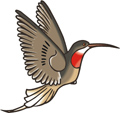Bird Watching: Into the Field |
Download PDF Form for Observing NH Birds |
The best way to observe birds is to get outside and observe them in their natural habitat. What You Need 1. Get a good pair of binoculars! They will help you get a close-up look at birds. The best binoculars for bird watching have a power of seven or higher. This means that objects you view will appear seven times closer than they actually are. 1. Get a good pair of binoculars! They will help you get a close-up look at birds. The best binoculars for bird watching have a power of seven or higher. This means that objects you view will appear seven times closer than they actually are.
2. Find a bird field guide to help you identify the birds you see. See if you can find a field guide for your area. Become familiar with how your field guide is organized. Most field guides group birds by order, then family, and then genra. This means all the ducks will be together, all the sparrows will be together, and all the owls will be together. Remember that for many bird species male, female, and immature birds may not look the same. Also keep in mind that some birds, like the common loon,
look different depending on the season. 4. Bring a journal or notepad so you can record what you see. 5. Bring a camera so you can take pictures of what you see. Where to GoStart close to home! Your own yard, neighborhood, or schoolyard may be a good place to start. Parks, hiking trails, lakes, shores, wetlands, and meadows are all good locations for bird watching.What to Look For Learning more about basic bird shapes, size, bills, plumage, behavior, and habitat can help you identify birds. For example, you are not going to find a crow swimming in the ocean and you will not find a swan sitting in a tree! Pay attention to movement in the trees and bushes. Know what birds you are likely to find in the area and where those birds are likely to be. Is the bird a ground-dweller or is it more likely to be found in the canopy of the trees? When is the bird active? Does the bird usually travel in flocks, small groups, pairs, or alone? Is the bird a migrant? What time of the year is it most likely to be found? Learning more about basic bird shapes, size, bills, plumage, behavior, and habitat can help you identify birds. For example, you are not going to find a crow swimming in the ocean and you will not find a swan sitting in a tree! Pay attention to movement in the trees and bushes. Know what birds you are likely to find in the area and where those birds are likely to be. Is the bird a ground-dweller or is it more likely to be found in the canopy of the trees? When is the bird active? Does the bird usually travel in flocks, small groups, pairs, or alone? Is the bird a migrant? What time of the year is it most likely to be found?
What to Listen ForSometimes bird watching is really about bird listening! Listening for bird calls and songs can not only help you locate birds, but can also help you identify birds. Many species of birds look very similar and the easiest way to tell them apart is by their calls and songs.Create a Space for BirdsThink about ways you can attract birds to your yard. Providing food, water, and shelter for birds can turn you yard into a bird haven! Is there a place where you can put up a bird feeder? Are their plants in your yard that attract birds? For example, sunflowers will attract a number of bird species that feed on their seeds. Bushes with berries will also attract birds. You can learn more about creating a space for birds and other wildlife at the National Wildlife Federation's Garden for Wildlife Program. |
|
